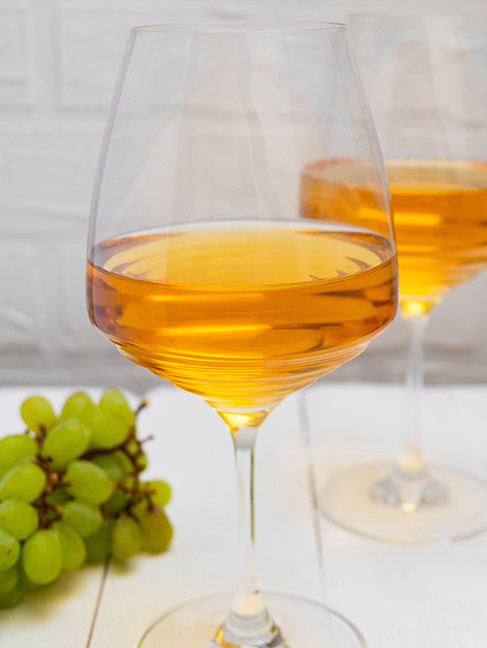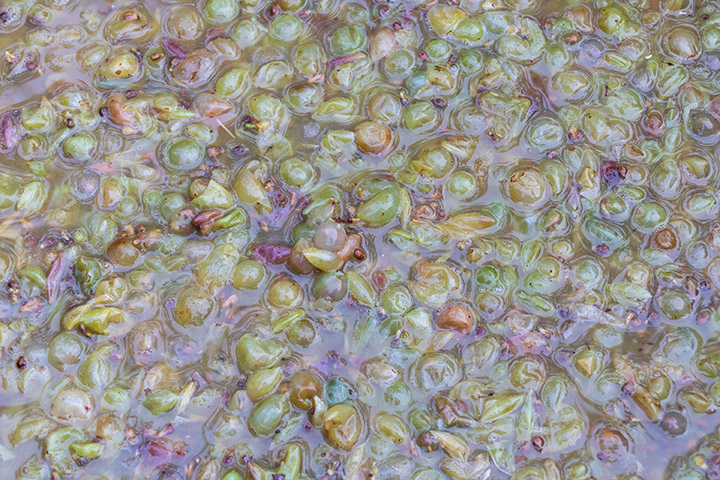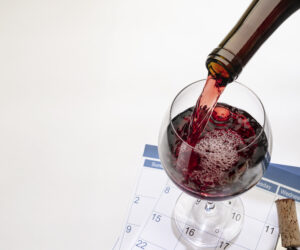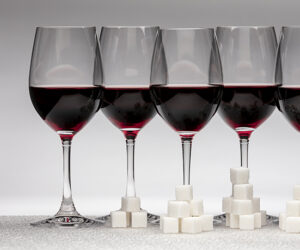Unlike a liqueur along the lines of Arancello, made using the zest of actual oranges, the fruit used in orange wine is white grapes. In this case, “orange” refers to the amber-to-orangish color that these wines acquire during production. Orange wine is a member of a broad and varied class of wines that fall under the general category of “skin-contact white wine.”
When you read books or take classes on home winemaking (including most of my writing and teaching), you are taught that red wine is made by crushing purple-skinned grapes and fermenting the sugars in the juice while those skins remain present in the fermenting must, while white wine is made by pressing the juice out of white-skinned grapes (either as whole clusters or crushed), and fermenting the sugars in the juice without the presence of the skins. Rosé wines, with pink colors coming from the skins of dark-skinned grapes by one of several methods, are usually set aside in a separate chapter or lesson as a special case. Skin-contact white wines, including orange wine, are even less commonly discussed than rosés. In this column, we will turn our attention to this currently trendy but infrequently taught category of wine you can make at home.

While it seems to be trending, skin-contact style wine made from white grapes was probably the standard method for using white grapes in ancient and pre-industrial times. Before modern presses were developed and techniques were introduced to minimize air contact, making the clear, unoxidized juice like we now ferment into white wine would have been very difficult. Rather, if you happened to be growing a white grape variety, the wine was probably made with at least pre-fermentation maceration on the skins and possibly with skins present all the way through primary fermentation, just as with red wines. Even today, the nation of Georgia continues to follow ancient cultural practices of using buried earthenware vessels known as kvevri to macerate and ferment wines — red and white — in the presence of pomace (skins, pulp, seeds, and stems) undisturbed for periods up to several months.
Today, commercial wineries can minimize skin contact using modern whole-cluster pressing. This equipment is so efficient that wine such as sparkling blanc de noirs can be made from dark-skinned grapes like Pinot Noir and Pinot Meunier and come out nearly as pale as a blanc de blancs. These conditions are difficult to reproduce with home equipment and try as you might, the palest rosé you are likely to make will still have a trace of pink color when you pour it. That is not a problem, of course, unless you are just trying to make a very pale pink or even white wine from what are normally red wine grapes. On the other hand, embracing some color from white wine grapes is simple, pleasing, and echoes ancient winemaking.
Cold Soaking for Aroma, Not Color
The starting level of skin contact for white wines contributes little or no color and the maceration extends for just a matter of hours after crushing. Most winemakers who use a short maceration of this type on their white wine are seeking release of aroma compounds that are otherwise bound in the skins of the grapes, but pressing off before color or tannins are significantly extracted. Adding macerating enzymes intended for use in white wine can accelerate the release of aromas to allow earlier pressing of the juice to minimize oxidation risk. I first heard of cold soaking crushed white grapes to assist with aroma release from Fred Brander of Brander Vineyards in Los Olivos, California. Years before I moved to Sonoma County and planted a hobby vineyard, Brander was making award-winning Sauvignon Blanc and other varietals at his pioneering vineyard and winery in Santa Barbara County. My wife, Marty White, and I had been college classmates with Fred Brander at Harvey Mudd College in Claremont, California, and we were excited to see what he was doing just a couple of hours northwest of there in the emerging Central Coast region. As he showed us around his winery, Fred noted that he harvested the Sauvignon Blanc very early in the morning, crushed it, and then fork-lifted the bins into his cooled barrel room for an overnight soak before pressing. Color was not the goal, but the aromas were wonderful in the resulting wine. Not orange, but my first contact with skin contact!
Today, when I make my own estate Chardonnay, I crush the fruit, add macerating enzymes, and press the juice within just a few hours. Chardonnay is not the most aromatic of the white grapes, so I want to get all I can while still avoiding oxidation. This aroma-enhancing but color-avoiding cold soak approach can be applied to many white wine grapes, but like the rest of life it is not just black and white — or red and white, in this case. We talk about purple-, red-, or black-skinned grapes for red wine, but usually just note that the color in the wine comes from the skins since the pulp is white. Except for those grapes where it isn’t, such as Alicante Bouschet, with its vivid purple juice. On the opposite side of the blurred fence are white wine grapes like Pinot Gris/Grigio, Trousseau Gris, and even Gewürztraminer that are usually harvested with golden, pink, bronze, or pale purple skin color.
While not necessarily made as full-on orange wines, these varieties so easily give up some color to “white” juice that specific wines have developed regionally to take advantage of that characteristic. In the Veneto and other nearby regions of Italy, a wine style called ramato, meaning copper-colored, is a DOC level wine that shows pale amber color developed through maceration of Pinot Grigio grapes on the skins. Some North American producers also make wines from these varieties with the specific intent of extracting color and sometimes light tannins. Without restrictive DOC-type systems, domestic producers may label such wines as ramato, skin contact, or other descriptive terms. A domestic skin-contact Pinot Gris I have particularly enjoyed is produced by Horse & Plow Winery of Sebastopol, California, from a single block of Pinot Gris grapes in Napa Valley. Besides being a delicious and aromatic wine, this one is also interesting because in some vintages the winery also makes a conventional whole-cluster-pressed Pinot Gris from the same vineyard. That one, without skin contact, is very pale and also delicious, and I would not have guessed the grapes came from the same vineyard just from tasting both wines.
Fermenting on the Skins
The next level of skin-contact whites is orange wine — sometimes called amber wine — that is macerated and fermented on the skins, just like red wine. Commercial wines aspiring to meet international labeling standards for orange wine are directed by the OIV (International Organization of Vine and Wine) that orange/amber wine is white wine with skin maceration of at least one month. As we are home winemakers, we can do whatever suits our needs and capabilities. With encouragement from an orange wine-loving friend, I decided to separate off a small part of my 2021 homegrown Chardonnay harvest and give orange wine a try.

On September 26, a small crew of friends and family helped me harvest my Chardonnay. ETS Laboratories later analyzed the juice for me, which came in at 20.5 °Brix, 3.2 pH, and 8.7 g/L TA. I crushed and destemmed the 400 lbs. (180 kg) of Chardonnay grapes into 32-gallon (120-L) plastic bins, added 50 mg/L sulfite, and later stirred in Lallzyme Cuvée Blanc macerating enzyme as directed on the package. A few hours later, after picking and crushing the Pinot Noir, I set aside 60 lbs. (27 kg) of macerating Chardonnay grapes in a 10-gallon (38-L) bucket, put the lid on, and pressed the remainder of the Chardonnay juice into a stainless steel tank to chill and settle overnight.
The next day, I inoculated my orange wine bucket with 5 grams of Lalvin 71B yeast and placed the fermenter alongside my Pinot Noir red wine fermenters. By evening, a cap had risen and I began my twice-daily punchdowns. After three days, I added 1 g/gallon Fermaid K nutrient and punched it in. Twice daily punchdowns continued until October 6; 10 days after harvest. That day, I pressed the orange Chardonnay must in my basket press, filling a 3-gallon carboy and a half-gallon jug (11 L and 2 L). My hydrometer reading measured Brix at -0.5, indicating the primary fermentation was very nearly complete. My tasting notes say, “tart, tannic, and grippy. Looks like thin pea soup, just slightly browner than (conventional) Chardonnay.”
Since the initial TA was nearly half malic acid, I decided to use malolactic fermentation (MLF) to bring the wine into better balance. Using Viniflora Oenos 2.0 malolactic bacteria culture because of its tolerance down to pH 3.2, I inoculated my wines and set up a space heater to keep one small room at 65 °F (18 °C) through completion. After four weeks, paper chromatography showed completion of MLF in my small batch of orange Chardonnay.
I racked the combined 3.5 gallons (13 L) to a single, topped-up 3-gallon (11-L) carboy and sulfited with 30 mg/L. After aging in bulk for six months, I racked the orange Chardonnay to a bottling bucket and bottled a dozen 750-mL bottles in flint (clear) claret bottles. I tasted the wine on bottling day and I was not impressed. There was no fault and the acid had come into balance, but it was just slightly more “grippy” on the palate from tannins and very pale amber in color. An adequate wine, but not exciting. I put my one case on the wine rack in the dark of my cellar and left it.
At Thanksgiving of 2024, the friend who had suggested it asked how that wine turned out. I had to admit that it worked, but seemed lackluster at bottling and that I had ignored it ever since. Her inquiry, though, prompted me to get a bottle out, chill it, and try it. I was pleasantly surprised. More than with my conventional Chardonnay, bottle age made a clear positive difference. The wine was mellow, the grip of the tannins firm but smooth, and the color developed into a golden-amber. Maybe I shouldn’t have been so surprised. Since it is made like red wine, why shouldn’t it bottle age like red wine? I gave a bottle to my friend and she (generously) said it was the best orange Chardonnay she had yet tasted.
I am still not an orange wine convert, but I can say I am now more open minded. Tannins, bulk aging, and bottle age can give a very nice and completely different wine from the same white wine vineyard. I did not give my wine a full month of skin maceration so it does not meet OIV standards, but I am a home winemaker and I can do what I like. You can, too. If you grow white grapes or routinely make white wines from purchased fruit, try setting some grapes aside and make a batch of a trendy ancient wine.







